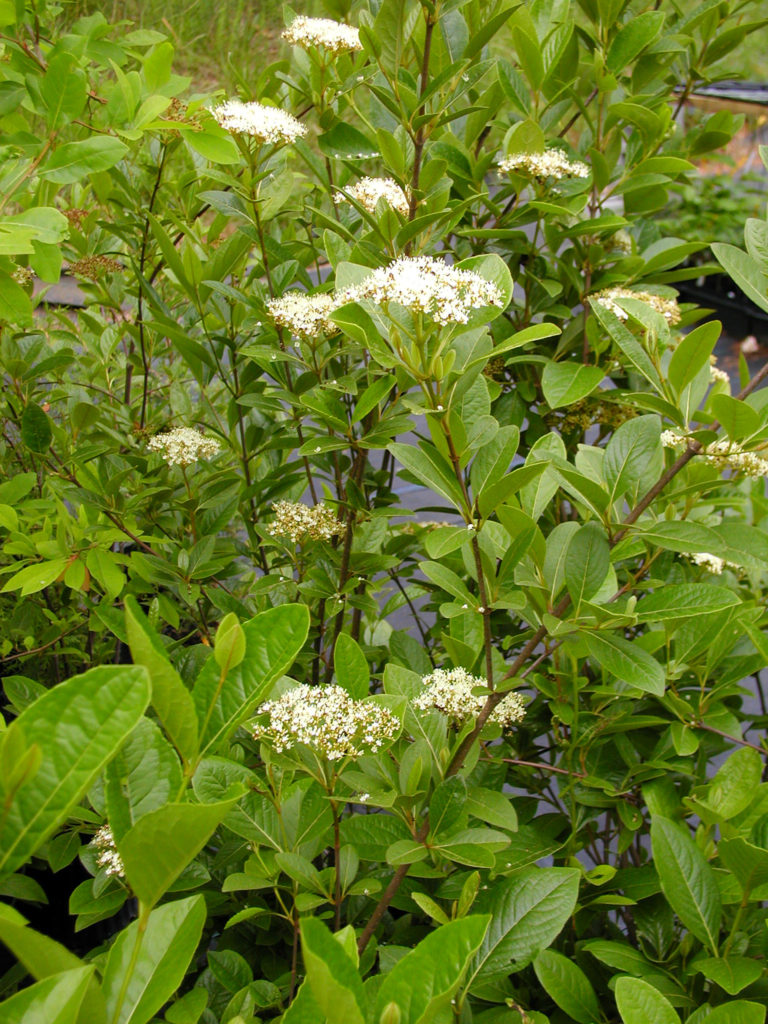Possumhaw Viburnum is a 12-15-foot tall (some report up to 20 feet) x 12-15-foot wide, deciduous, wet-tolerant shrub of surprising ornamental value found in Eastern states from Texas north to Canada. It ioccurs in all three NC zones, mountains, piedmont and coastal plain, though in the mountains the quite similar Viburnum cassinoides is more common. The stems are upright to arching, leaves are simple, smooth and glossy, white-topped cymes of flowers are abundant in April and May. It is the changing colors of the fruits of Possumhaw Viburnum that are most striking: they begin as a heavy load of pink berries, which ripen – fetchingly unevenly – to deep blue as the season progresses. As the foliage turns to deep burgundy in the fall, the berries darken to blue-black! Grow in full sun to part shade, average to wet soil moisture. The colors will surprise you, and the birds will love you for it.
NURSERY HOURS
Wednesday: 10-4 Thursday: 10-6 Friday-Saturday: 10-4 Sunday: 12-4
Viburnum nudum

Key Info
Scientific Name: Viburnum nudum L.
Common Names: Possumhaw Viburnum, Smooth Witherod, Wild Raisin, Naked Viburnum
Family Names: Adoxaceae (Viburnum Family)
Plant Type: Tree / Shrub
Leaf Retention: Deciduous
Flower Color: White
Additional Info
Habit: Upright, multi-stemmed shrub with rounded crown that typically grows in the wild to 5-12’ reaching up to 20 feet tall, with a spreading, round crown. The bark is gray-brown and smooth with a few raised warty lenticels.
Height: 10' to 15'
Spread: 10' to 15'
Soil Conditions: Occasionally saturated to consistently moist, well-drained soil, and even occasionally dry soil, acid, loam, loamy clay.
Leaves: Opposite, simple, elliptical, dark green, 3 - 5 inches long, wavy-edged or with entire margins, somewhat thickened; waxy-shiny green above, paler below. Foliage reliably turns attractive shades of maroon/burgundy-purple in fall.
Flowers (or reproductive structures: In spring, aromatic, long-stemmed, creamy white flowers appear, arranged in flat-topped clusters (cymes) 2-5” wide.
Fruit: Fruits occur in hanging clusters of oval drupes ½ inch long that are at first light pink, then deep pink, deep blue, ripening to purplish black, several colors in the same cluster. They ripen in the fall and persist through the winter, becoming shrivelled (raisin like). The berries are highly acidic but edible.
Natural Distribution: Low, wet woods, bogs, swamps, savannas.
USDA Hardiness Zone: 5 to 9
USDA Wetland Indicator Status in NC: OBL (FACW on costal plain)
Pollination: Bees, butterflies, other insects
Wildlife Connections: Its fruits are eaten by songbirds, water birds, grouse, wild turkeys and squirrels; is a potential host plant for the Spring Azure butterfly; the twigs and leaves are browsed by small mammals and white-tailed deer.
Propagation: Propagated by cuttings in spring or by seeds.
